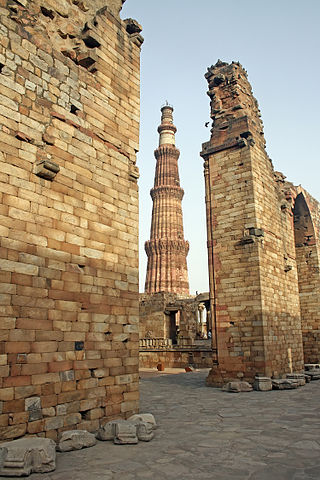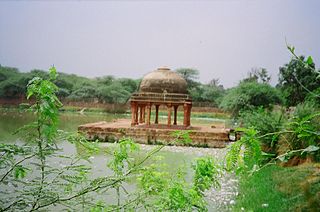
The Qutb Minar complex are monuments and buildings from the Delhi Sultanate at Mehrauli in Delhi, India. Construction of the Qutub Minar "victory tower" in the complex, named after the religious figure Sufi Saint Khwaja Qutbuddin Bakhtiar Kaki, was begun by Qutb-ud-din Aibak, who later became the first Sultan of Delhi of the Mamluk dynasty. It was continued by his successor Iltutmish, and finally completed much later by Firoz Shah Tughlaq, a Sultan of Delhi from the Tughlaq dynasty (1320–1412) in 1368 AD. The Qubbat-ul-Islam Mosque, later corrupted into Quwwat-ul Islam, stands next to the Qutb Minar.

Mandu or Mandavgad is an ancient city in the present-day Mandav area of the Dhar district. It is located in the Malwa and Nimar region of western Madhya Pradesh, India, at 35 km from Dhar city. In the 11th century, Mandu was the sub division of the Tarangagadh or Taranga kingdom. This fortress town on a rocky outcrop about 100 km (62 mi) from Indore is celebrated for its architecture.

Humayun's tomb is the tomb of Mughal emperor, Mirza Nasir al-Din Muhammad commonly known as Humayun situated in Delhi, India. The tomb was commissioned by Humayun's first wife and chief consort, Empress Bega Begum under her patronage in 1558, and designed by Mirak Mirza Ghiyas and his son, Sayyid Muhammad, Persian architects chosen by her. It was the first garden-tomb on the Indian subcontinent, and is located in Nizamuddin East, Delhi, close to the Dina-panah Citadel, also known as Purana Qila, that Humayun found in 1538. It was also the first structure to use red sandstone at such a scale. The tomb was declared a UNESCO World Heritage Site in 1993, and since then has undergone extensive restoration work, which is complete. Besides the main tomb enclosure of Humayun, several smaller monuments dot the pathway leading up to it, from the main entrance in the West, including one that even pre-dates the main tomb itself, by twenty years; it is the tomb complex of Isa Khan Niazi, an Afghan noble in Sher Shah Suri's court of the Suri dynasty, who fought against the Mughals, constructed in 1547 CE.

Mughal architecture is the type of Indo-Islamic architecture developed by the Mughals in the 16th, 17th and 18th centuries throughout the ever-changing extent of their empire in the Indian subcontinent. It developed from the architectural styles of earlier Muslim dynasties in India and from Iranian and Central Asian architectural traditions, particularly Timurid architecture. It also further incorporated and syncretized influences from wider Indian architecture, especially during the reign of Akbar. Mughal buildings have a uniform pattern of structure and character, including large bulbous domes, slender minarets at the corners, massive halls, large vaulted gateways, and delicate ornamentation; examples of the style can be found in modern-day Afghanistan, Bangladesh, India and Pakistan.

Mehrauli is a neighbourhood in South Delhi, Delhi, India. It represents a constituency in the legislative assembly of Delhi. The area is close to Gurugram and next to Vasant Kunj.

Purana Qila is one of the oldest forts in Delhi, India. It was built by the second Mughal Emperor Humayun and Surid Sultan Sher Shah Suri. The fort forms the inner citadel of the city of Dinpanah. It is located near the expansive Pragati Maidan exhibition ground and is separated from Dhyanchand Stadium by Mathura Road, Delhi.

Adham Khan's Tomb is the 16th-century tomb of Adham Khan, a general of the Mughal Emperor Akbar. He was the younger son of Maham Anga, Akbar's wet nurse thus also his foster brother. However, when Adham Khan murdered Akbar’s favourite general Ataga Khan in May 1562, Akbar immediately ordered his execution by defenestration from the ramparts of the Agra Fort.

Delhi has been an important political centre of India as the capital of several empires. The recorded history of Delhi begins with the 8th century Tomar Rajput dynasty. It is considered to be a city built, destroyed and rebuilt several times, as outsiders who successfully invaded the Indian subcontinent would ransack the existing capital city in Delhi, and those who came to conquer and stay would be so impressed by the city's strategic location as to make it their capital and rebuild it in their own way.

Safdarjung's tomb is a sandstone and marble mausoleum in Delhi, India. It was built in 1754 in the late Mughal Empire style for Nawab Safdarjung. The monument has an ambience of spaciousness and an imposing presence with its domed and arched red, brown and white coloured structures. Safdarjung, Nawab of Oudh, was made prime minister of the Mughal Empire when Ahmed Shah Bahadur ascended the throne in 1748.
Shaikh Jamali Kamboh was a 16th-century Punjabi Muslim poet and Sufi of the Suhrawardiyya Order and pupil of Poet Jami and of Shaikh Sama'al-Din Kamboh'.

Sultan Ghari was the first Islamic Mausoleum (tomb) built in 1231 AD for Prince Nasiruddin Mahmud, eldest son of Iltumish, in the "funerary landscape of Delhi" in the Nangal Dewat Forest, Near Nangal Dewat Vasant Kunj).

Hauz-i-Shamsi, also known as Shamsi Talab, is a water reservoir built by Iltutmish of the Slave Dynasty in 1230 CE. According to legend, its location was revealed to him in a dream by the Islamic prophet Muhammad. A palace known as the Jahaz Mahal was constructed on the eastern edge of the same reservoir during the Lodi dynasty in the 16th century, serving as a retreat or inn for pilgrims. At the edge of Hauz-i-Shamsi stands the tomb of Abdul-Haqq Dehlavi, a 17th-century Persian writer at the Mughal court. The monuments are situated in the sprawling environs of Mehrauli, Delhi.

Zafar Mahal, in Mehrauli village, in South Delhi, India, is considered as the last monumental structure built as a summer palace during the fading years of the Mughal era. The building has two components namely, the Mahal or the palace, which was built first by Akbar Shah II in the 18th century, and the entrance gate that was reconstructed in the 19th century by Bahadur Shah Zafar II, popularly known as "Zafar" meaning ‘Victory’. It has a forlorn history because Bahadur Shah Zafar, who wished to be buried in the precincts of the Zafar Mahal (palace) and the famous Dargah of Khwaja Qutubuddin Bakhtiar Kaki in Mehrauli, Delhi, was deported by the British to Rangoon, after the First War of Indian Independence in 1857, where he died of old age. The monument today is in a neglected and ruined state, locals play cricket and gamble freely inside the protected monument. The 18th-century palace has been all but subsumed by unauthorised constructions.

Rajon ki Baoli also referred as Rajon ki Bain is a famous stepwell in Mehrauli Archaeological Park of Delhi, India.

Mehrauli Archaeological Park is an archaeological area spread over 200 acre in the Mehrauli neighbourhood of the South Delhi district of Delhi, India, adjacent to the Qutub Minar and the Qutb complex. It consists of over 100 historically significant monuments. It is the only area in Delhi known for 1,000 years of continuous occupation, and includes the ruins of Lal Kot built by Tomar Rajputs in 1060 CE, making it the oldest extant fort of Delhi, and architectural relics of subsequent period, rule of Khalji dynasty, Tughlaq dynasty, Lodhi dynasty of Delhi Sultanate, Mughal Empire, and the British Raj.

Persian Inscriptions on Indian Monuments is a book written in Persian by Dr Ali Asghar Hekmat E Shirazi and published in 1956 and 1958 and 2013. New edition contains the Persian texts of more than 200 epigraphical inscriptions found on historical monuments in India, many of which are currently listed as national heritage sites or registered as UNESCO world heritage, published in Persian; an English edition is also being printed.

The Baolis of Mehrauli are four stepwells approached through single stage or three stage steps, located in Mehrauli in Delhi, India, in the Mehrauli Archaeological Park mainlined by the Archaeological Survey of India. These are the Anangtal Baoli, the Gandhak Ki Baoli, and the Rajon Ki Baoli. These were built below the ground level as ground water edifices and were built near shrines in medieval times.

The Kabuli Bagh Mosque is a mosque in Panipat, Haryana, India which was built in 1527 by the emperor Babur to mark his victory over Sultan Ibrahim Lodhi at the first Battle of Panipat in 1526. The mosque is named after Kabuli Begum, Babur's wife.

The tomb of the noble Isa Khan Niazi is located in the Humayun's Tomb complex in Delhi, India. The mausoleum, octagonal in shape and built mainly of red sandstone, was built in 1547–1548 during the reign of Sher Shah Suri. The mosque of Isa Khan is located west of the mausoleum, which along with other buildings form the UNESCO World Heritage Site of Humayun's tomb complex.




























